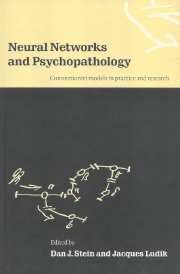Book contents
- Frontmatter
- Contents
- List of contributors
- Preface
- Part one General Concepts
- 1 Neural networks and psychopathology: an introduction
- 2 The history of neural network research in psychopathology
- 3 Neural network models in psychiatric diagnosis and symptom recognition
- 4 Neural networks and psychopharmacology
- 5 A connectionist view of psychotherapy
- 6 Modulatory mechanisms in mental disorders
- Part two Clinical disorders
- Epilogue
- Index
4 - Neural networks and psychopharmacology
from Part one - General Concepts
Published online by Cambridge University Press: 12 January 2010
- Frontmatter
- Contents
- List of contributors
- Preface
- Part one General Concepts
- 1 Neural networks and psychopathology: an introduction
- 2 The history of neural network research in psychopathology
- 3 Neural network models in psychiatric diagnosis and symptom recognition
- 4 Neural networks and psychopharmacology
- 5 A connectionist view of psychotherapy
- 6 Modulatory mechanisms in mental disorders
- Part two Clinical disorders
- Epilogue
- Index
Summary
Introduction
Psychopharmacological models have been developed from the two traditions now known as artificial neural networks and computational neuroscience. Artificial neural networks are based on primitive computing elements that are arranged to provide a brain-like architecture for information processing that contrasts with symbolic accounts of mental function. Computational neuroscience developed from mathematical models of phenomena at the level of the single neuron. Psychopharmacological models are on a spectrum between these two approaches, both of which have potential weaknesses. Artificial neural network models may include too many simplifying assumptions accurately to reflect pharmacological effects. Conversely, a model that incorporates too much cellular detail will be too complex to be useful in providing an explanation of network behaviour. This is reflected in the functions of these two types of model. Detailed models generally aim to replicate the causal mechanisms of a network and seek explanatory status through simplification. Artificial neural networks are used in a more limited fashion as hypothesis-generating tools. Available computing power leads to a trade-off between the size of a network and the amount of detail included. However, increasing power is leading to a convergence in the modelling process. The simplifications involved in model abstraction can be increasingly assessed against the behaviour of networks of much more detailed and biologically realistic neurons.
Psychopharmacology lacks a theoretical framework relating events at the level of the neuron to those at higher levels of central nervous system organization. Despite a wealth of detail on the cellular and behavioural effects of psychotropic drugs, the relation between the two remains obscure.
- Type
- Chapter
- Information
- Neural Networks and PsychopathologyConnectionist Models in Practice and Research, pp. 57 - 87Publisher: Cambridge University PressPrint publication year: 1998
- 1
- Cited by



